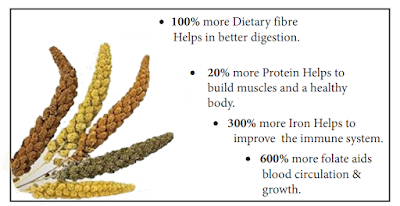Millets are often considered better than white rice for several reasons, primarily related to their nutritional content, health benefits, and environmental sustainability. Here are some key advantages of millets over white rice:
1. Nutritional Content
Higher Fiber Content: Millets are rich in dietary fiber, which aids in digestion, helps maintain blood sugar levels, and supports heart health. White rice, on the other hand, is low in fiber due to its refining process.
More Nutrients: Millets contain higher amounts of essential nutrients like vitamins (B vitamins, vitamin D), minerals (calcium, iron, magnesium, phosphorus, potassium), and antioxidants compared to white rice, which loses many nutrients during processing.
Protein Content: Millets have a higher protein content compared to white rice, making them a better option for muscle repair and overall bodily functions.
2. Health Benefits
Low Glycemic Index: Millets generally have a lower glycemic index than white rice, which means they cause a slower, steadier rise in blood glucose levels. This makes them a better choice for managing diabetes and controlling blood sugar levels.
Better for Weight Management: Due to their higher fiber content, millets can help with satiety and weight management by keeping you full for longer periods.
Rich in Antioxidants: Millets contain various antioxidants that help combat oxidative stress and inflammation in the body, contributing to overall health and disease prevention.
3. Digestive Health
- Supports Gut Health: The high fiber content in millets promotes healthy digestion and prevents constipation, supporting overall gut health. White rice, especially when stripped of its bran and germ, lacks this benefit.
4. Environmental Sustainability
Drought-Resistant: Millets are more resilient to harsh growing conditions, including drought, compared to rice, which requires a lot of water. This makes millets a more sustainable and environmentally friendly choice.
Low Input Crop: Millets generally require fewer agricultural inputs, such as fertilizers and pesticides, compared to rice, which can contribute to a more sustainable agricultural practice.
5. Versatility
- Diverse Uses: Millets can be used in various forms, including whole grains, flour, or as part of different recipes. They can be incorporated into bread, porridge, snacks, and more, providing dietary variety.
6. Minimal Processing
- Less Refined: Millets are less processed than white rice, which means they retain more of their natural nutrients and health benefits. White rice undergoes polishing and refining that removes the bran and germ, reducing its nutritional value.
In summary, millets offer a range of health benefits and are more sustainable compared to white rice. Their superior nutritional profile, better glycemic index, and environmental advantages make them a worthwhile choice for a balanced and health-conscious diet.
• 100% more Dietary fibre Helps in better digestion.
• 20% more Protein Helps to build muscles and a healthy body.
• 300% more Iron Helps to improve the immune system.
• 600% more folate aids blood circulation & growth.


